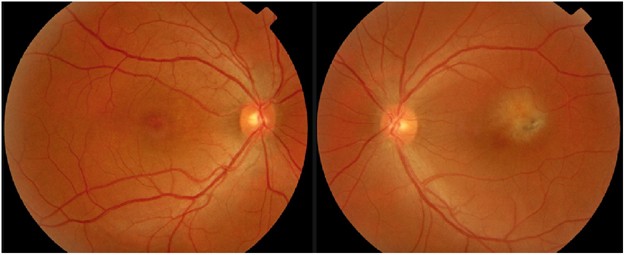Sir,
Toxoplasmosis lesions in the posterior pole are generally treated with anti-Toxoplasma drugs in association with high-dose oral corticosteroids.1 Our standard therapeutic regimen consists of a 6-week course of pyrimethamine, sulphadiazine, folinic acid, and oral prednisone, along with topical drops. However, there are situations in which systemic corticosteroids are contraindicated. Herein we report two such cases, treated with anti-Toxoplasma drugs and an intravitreal triamcinolone acetonide (IVTA) injection.
Case reports
A 30-year-old woman had central serous chorioretinopathy OD associated with high-dose corticosteroid use and active macular toxoplasmosis OS (Figure 1). At 7 days before presentation, she was started on pyrimethamine 25 mg daily, sulphadiazine 2 g daily, folinic acid 5 mg twice weekly, and prednisone 60 mg daily. Visual acuity was 20/50 OD and counting fingers OS. Oral prednisone was discontinued and 4 mg of triamcinolone acetonide was injected via pars plana OS under topical anesthesia. After 5 days, marked amelioration of the vitritis was seen, with visual acuity of 20/200 OS. At 1 month following the injection, visual acuity was 20/20 OD and 20/100 OS. Funduscopy was normal OD and disclosed a scarred toxoplasmosis lesion in the superotemporal macula OS (Figure 2). The medication was switched to oral trimethoprim-sulphamethoxazole (160/800 mg) three times a week for 3 months. At 18 months after IVTA injection, no signs of recurrence were noted.
Initial presentation. (Left) Fundus photography of the right eye (OD) revealing a circumscribed neurosensory retinal detachment in the posterior pole (arrows). (Right) Fundus photography of the left eye (OS) showing a whitish, fluffy lesion in the superotemporal macula, as well as marked vitritis. Fundus details are barely visible.
A 74-year-old difficult controlled diabetic man with active macular toxoplasmosis, along with severe anterior chamber reaction and vitritis OS, had visual acuity of 20/20 OD and hand movements OS. Pyrimethamine, sulphadiazine, and folinic acid were started. After 1 week, the picture was unchanged. In total, 4 mg of triamcinolone acetonide was injected via pars plana OS. After 7 days, marked diminution of anterior chamber and vitreous cells was noted. Treatment was switched to trimethoprim-sulphametoxazole at the 5th week and discontinued 3 months later. At 18 months following IVTA injection, visual acuity was CF at 3 m and signs of scarring were seen in the retinochoroidal lesion. No evidence of recurrence or active inflammation was detected.
Discussion
Kishore et al2 reported treating four patients with clindamycin and dexamethasone given intravitreally under general or peribulbar anesthesia. However, up to four injections were required to control the disease, and recurrence occurred in one case during a mean follow-up time of 17.5 months. Three patients, including the one with recurrence, continued one systemic antitoxoplasmic medication during follow-up.
IVTA has been efficient in rapidly decreasing inflammation in acute sight-threatening noninfectious uveitis.3, 4 In our study, a single injection of IVTA was used as an adjunct in the treatment of severe ocular toxoplasmosis, with rapid and successful control of the intraocular inflammation in both cases and no signs of recurrence during an 18-month follow-up period. Trimethoprim-sulphamethoxazole three times a week was used as a prophylactic treatment against the parasite in the period in which some triamcinolone acetonide residue might still be present in the vitreous cavity, potentially suppressing the immune response.
Conclusion
We suggest that IVTA should be considered as a potential benefit to patients with severe ocular toxoplasmosis or in which the use of systemic corticosteroids is contraindicated and should be investigated further. To our knowledge, this is the first report of IVTA in the treatment of infectious uveitis.4
References
Nussenblatt RB . Ocular toxoplasmosis. In: Nussenblatt RB, Whitcup SM (eds). Uveitis: Fundamentals and Clinical Practice, 3rd edn. Mosby: Philadelphia, 2004, pp 214–234.
Kishore K, Conway MD, Peyman GA . Intravitreal clindamycin and dexamethasone for toxoplasmic retinochoroiditis. Ophthal Surg Lasers 2001; 32: 183–192.
Benitez Del Castillo Sanchez JM, Garcia Sanchez J . Intravitreal injection of triamcinolone acetonide in non infectious uveitis. Arch Soc Esp Oftalmol 2001; 76: 661–664.
Jonas JB, Kreissig I, Degenring R . Intravitreal triamcinolone acetonide for treatment of intraocular proliferative, exudative and neovascular diseases. Prog Retin Eye Res 2005; 24: 587–611.
Author information
Authors and Affiliations
Corresponding author
Additional information
The authors have no proprietary interest in the development or marketing of this or any competing device.
Rights and permissions
About this article
Cite this article
Aggio, F., Muccioli, C. & Belfort, R. Intravitreal triamcinolone acetonide as an adjunct in the treatment of severe ocular toxoplasmosis. Eye 20, 1080–1082 (2006). https://doi.org/10.1038/sj.eye.6702113
Published:
Issue Date:
DOI: https://doi.org/10.1038/sj.eye.6702113
This article is cited by
-
Ocular toxoplasmosis: a review of the current diagnostic and therapeutic approaches
International Ophthalmology (2022)
-
Intravitreal triamcinolone acetonide as an adjunct in the treatment of severe ocular toxoplasmosis
Eye (2008)
-
Intravitreal triamcinolone acetonide as an adjunct in the treatment of severe ocular toxoplasmosis
Eye (2008)
-
Active ocular toxoplasmosis in Turkish patients: a report on 109 cases
International Ophthalmology (2007)


